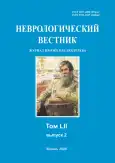Relationship of background electroencephalogram with cognitive impairment in patients with alcohol dependence
- Authors: Galkin S.A.1, Peshkovskaya A.G.1, Roshchina O.V.1, Belokrylov I.I.1, Bokhan N.A.1,2
-
Affiliations:
- Mental Health Research Institute, Tomsk National Research Medical Center of the Russian Academy of Sciences
- Siberian State Medical University
- Issue: Vol LII, No 2 (2020)
- Pages: 67-71
- Section: Original study arcticles
- Submitted: 08.05.2020
- Accepted: 29.05.2020
- Published: 19.10.2020
- URL: https://journals.eco-vector.com/1027-4898/article/view/34027
- DOI: https://doi.org/10.17816/nb34027
- ID: 34027
Cite item
Abstract
A significant number of studies have focused on the neurophysiological basis of cognitive dysfunction among individuals with neurological and psychiatric disorders, including alcoholism. However, the neural correlates of cognitive deficits in alcohol dependence are still not clear enough.
The purpose of the study: to identify the relationship of background electroencephalogram indicators with cognitive disorders in patients with alcohol dependence.
Material and methods. 107 patients with alcohol dependence aged 30 to 60 years after detoxification were examined. The background electroencephalogram was recorded with closed eyes for 2 min. The values of the absolute spectral power of theta, alpha and beta rhythms were analyzed. The study of the level of Executive functioning was conducted using the Go/Nogo test. The level of spatially working memory was evaluated using the Corsi Block-Tapping test.
Results. Data analysis revealed statistically significant correlations between the spectral power of the alpha rhythm in the occipital cortex and the number of errors per inhibitory signal (Nogo) in the Go/Nogo problem (r=–0.287; p=0.025). There were also statistically significant correlations between the values of alpha-rhythm spectral power and working memory in the Corsi test in the parietal cortex (r=0.273; p=0.037), occipital cortex (r=0.316; p=0.015) and temporal cortex (r=0.359; p=0.005). There were no statistically significant correlations of beta and theta rhythms with the results of cognitive tests (p >0.05).
Conclusion. Thus, all of the above results indicate that the background EEG indicators, in particular the spectral power of alpha activity, can with a certain probability indicate violations of cognitive functioning (inhibitory control and working memory) in patients with alcohol dependence.
Full Text
About the authors
Stanislav A. Galkin
Mental Health Research Institute, Tomsk National Research Medical Center of the Russian Academy of Sciences
Author for correspondence.
Email: s01091994@yandex.ru
Russian Federation, 634014, Tomsk, Aleutskaya str., 4
Anastasiya G. Peshkovskaya
Mental Health Research Institute, Tomsk National Research Medical Center of the Russian Academy of Sciences
Email: s01091994@yandex.ru
Russian Federation, 634014, Tomsk, Aleutskaya str., 4
Olga V. Roshchina
Mental Health Research Institute, Tomsk National Research Medical Center of the Russian Academy of Sciences
Email: s01091994@yandex.ru
Russian Federation, 634014, Tomsk, Aleutskaya str., 4
Il’ya I. Belokrylov
Mental Health Research Institute, Tomsk National Research Medical Center of the Russian Academy of Sciences
Email: s01091994@yandex.ru
Russian Federation, 634014, Tomsk, Aleutskaya str., 4
Nikolaj A. Bokhan
Mental Health Research Institute, Tomsk National Research Medical Center of the Russian Academy of Sciences; Siberian State Medical University
Email: s01091994@yandex.ru
Russian Federation, 634014, Tomsk, Aleutskaya str., 4; 634050, Tomsk, Moscow trakt, 2
References
- Бохан Н.А., Мандель А.И., Иванова С.А. и др. Старые и новые проблемы наркологии в контексте междисциплинарных исследований. Вопр. наркол. 2017; (1): 26–62. [Bokhan N.A., Mandel A.I., Ivanova S.A. et al. Old and new problems of narcology in the context of interdisciplinary research. Voprosy narkologii. 2017; (1): 26–62. (In Russ.)]
- Белокрылов И.И., Пешковская А.Г., Галкин С.А., Рощина О.В. Когнитивное функционирование и психотравмирующие ситуации в контексте алкогольной зависимости. Вопр. наркол. 2018; (12): 81–92. [Belokrylov I.I., Peshkovskaya A.G., Galkin S.A., Roshchina O.V. Cognitive functioning and psychotraumatic situations in the context of alcohol dependence. Voprosy narkologii. 2018; (12): 81–92. (In Russ.)]
- Пешковская А.Г., Галкин С.А. Когнитивный контроль при алкогольной зависимости и его нейрокорреляты. Вопр. наркол. 2018; 12: 65–80. [Peshkovskaya A.G., Galkin S.A. Cognitive control in alcohol dependence and its neurocorrelates. Voprosy narkologii. 2018; 12: 65–80. (In Russ.)]
- Le Berre A.P., Fama R., Sullivan E.V. Executive functions, memory, and social cognitive deficits and recovery in chronic alcoholism: A critical review to inform future research. Alcoholism, Clin. Experim. Res. 2017; 41 (8): 1432–1443. doi: 10.1111/acer.13431.
- Buzsáki G., Anastassiou C.A., Koch C. The origin of extracellular fields and currents — EEG, ECoG, LFP and spikes. Nat. Rev. Neurosci. 2012; 13 (6): 407–420. doi: 10.1038/nrn3241.
- Mumtaz W., Vuong P.L., Malik A.S., Rashid R. A review on EEG-based methods for screening and diagnosing alcohol use disorder. Cogn. Neurodyn. 2018; 12 (2): 141–156. doi: 10.1007/s11571-017-9465-x.
- Галкин С.А. Клинико-нейрофизиологические особенности коморбидности алкогольной зависимости и аффективных расстройств. Неврол. вестн. 2019; (3): 57–59. [Galkin S.A. Clinical and neurophysiological features of comorbidity of alcohol dependence and affective disorders. Nevrologicheskiy vestnik. 2019; (3): 57–59. (In Russ.)]
- Gomez P., Ratcliff R., Perea M. A model of the go/no-go task. J. Exp. Psychol. Gen. 2007; 136 (3): 389–413. doi: 10.1037/0096-3445.136.3.389.
- Brunetti R., Del Gatto C., Delogu F. eCorsi: implementation and testing of the Corsi block-tapping task for digital tablets. Front. Psychol. 2014; 5: 939. doi: 10.3389/fpsyg.2014.00939.
- Рева Н.В., Коренек В.В., Павлов С.В. Взаимосвязь фоновой биоэлектрической активности головного мозга с личностными характеристиками и сердечно-сосудистой реактивностью на эмоциональный вызов. Бюлл. Сибирского отделения РАМН. 2010; (4): 116–123. [Reva N.V., Korenek V.V., Pavlov S.V. Correlation of background bioelectric activity of the brain with personal characteristics and cardiovascular reactivity to an emotional challenge. Byulletenʹ Sibirskogo otdeleniya Rossiyskoy akademii meditsinskikh nauk. 2010; (4): 116–123. (In Russ.)]
- Buzsáki G., Watson B.O. Brain rhythms and neural syntax: implications for efficient coding of cognitive content and neuropsychiatric disease. Dialogues Clin. Neurosci. 2012; 14 (4): 345–367.
- McCabe D.P., Roediger H.L., McDaniel M.A. et al. The relationship between working memory capacity and executive functioning: evidence for a common executive attention construct. Neuropsychology. 2010; 24 (2): 222–243. doi: 10.1037/a0017619.
- Diamond A. Executive functions. Annu. Rev. Psychol. 2013; 64: 135–168. doi: 10.1146/annurev-psych-113011-143750.
- Rabinovici G.D., Stephens M.L., Possin K.L. Executive dysfunction. Continuum (Minneap. Minn.). 2015; 21 (3): 646–659. doi: 10.1212/01.CON.0000466658.05156.54.
Supplementary files








